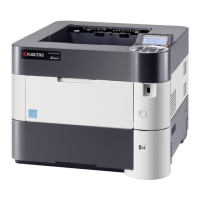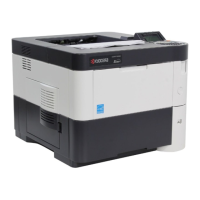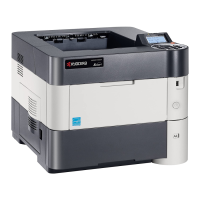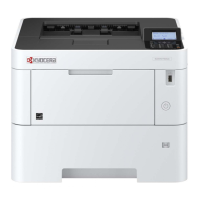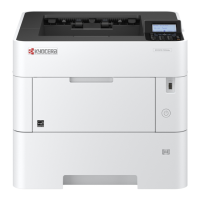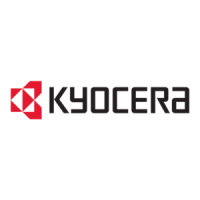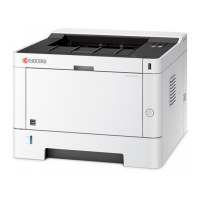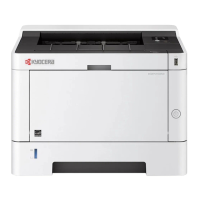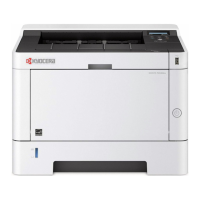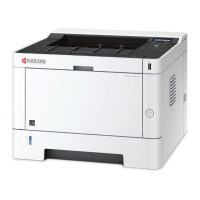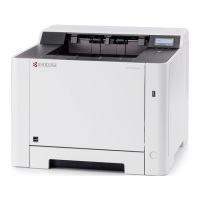Do you have a question about the Kyocera ECOSYS P3260dn and is the answer not in the manual?
Locates and explains the importance of the equipment's serial number for service inquiries.
Details on saving frequently used documents in the machine for efficient workflow.
Explains energy-saving functions and using less toner for cost reduction.
Information on protecting data on the SSD via encryption or overwriting.
How to temporarily save and print documents to prevent unauthorized access.
Details on security functions available for administrators to enhance machine security.
How to configure the machine for quieter operation using Quiet Mode.
Instructions for installing the machine using wireless network capabilities like Wi-Fi Direct.
Guidance on printing documents directly from a USB drive.
How to access and manage the machine remotely using Command Center RX.
Explains safety warnings, symbols, and conventions used throughout the guide for safe operation.
Details the recommended temperature and humidity levels for machine operation.
Provides essential safety cautions when handling consumables like toner.
Details laser safety classifications and precautions for European and US standards.
Instructions for power disconnection and information on regulatory compliance (FCC, Industry Canada).
Covers specific precautions for California users and security for wireless LAN usage.
Addresses risks of illegal intrusion via wireless and limitations on product use in specific environments.
Provides legal information regarding guide reproduction and lists registered trade names.
Details the software licenses, including GPL, LGPL, OpenSSL, and SSLeay, used in the product.
Explains energy-saving controls, sleep modes, and the ENERGY STAR® program participation.
Identifies and illustrates the external parts of the machine for easy reference.
Illustrates and labels the machine's internal connectors and components.
Shows the machine with various optional equipment like paper feeders and caster kits attached.
Guides on connecting the machine to PCs or tablets via USB, network cable, Wi-Fi, or Wi-Fi Direct.
Provides instructions for connecting LAN and USB cables to the machine.
Details on how to connect the machine's power cable to a power outlet.
Explains the correct procedures for turning the machine's power on and off safely.
Introduces the operation panel keys and their functions for navigating the machine's interface.
Explains how to display menus and configure machine settings using the operation panel.
Describes how to access the Help screen on the operation panel for assistance with machine operations.
Details the steps for logging into and out of the machine for authorized access.
Guides on configuring initial machine settings like date, time, and network.
Step-by-step instructions for configuring the machine's wired network connection (TCP/IP).
Procedures for setting up the machine's wireless network connection.
Guides on configuring the Wi-Fi Direct connection for direct device-to-machine wireless printing.
Explains how to set up energy-saving functions like Sleep and Auto Sleep modes.
Instructions for installing printer drivers and software on Windows computers.
Procedure for removing installed software from the computer.
Guides for installing printer drivers and software on Mac computers.
How to check the machine's counter to view the number of sheets printed.
Steps for administrators to strengthen machine security, including user restrictions and data protection.
Overview of Command Center RX for configuring machine settings remotely via a web browser.
Instructions for loading paper into the multi-purpose tray and cassettes.
Guidelines and precautions for proper paper handling to avoid jams and ensure print quality.
Detailed steps for loading paper into the machine's cassettes, including size adjustment.
Procedure for loading Statement size paper into cassettes, including size adjustment.
Instructions for loading paper into the multi-purpose tray, including capacity and special paper use.
How to specify paper size and media type settings for cassettes and trays.
Instructions on opening the paper stopper for larger paper sizes like A4/Letter.
Step-by-step guide on how to print documents from PC applications using the printer driver.
How to register and print using paper sizes not pre-defined in the printer settings.
Instructions for setting up and performing banner printing with specific paper sizes.
Explains the various tabs and settings within the printer driver's print settings screen.
How to access the integrated help system within the printer driver for print settings.
Procedure to change default printer driver settings for frequently used options.
How to cancel print jobs initiated from a computer before they start printing.
Information on printing using AirPrint, Google Cloud Print, and Mopria standards.
Overview of printing jobs saved in the machine's Job Box from a computer.
Steps to print documents stored in the Private Print Box, ensuring job confidentiality.
How to print documents previously saved and stored in the Stored Job Box.
Procedure for reprinting documents stored in the Quick Copy Box for additional copies.
How to print a proof copy and hold the remaining copies of a multi-print job.
Configuration options for Job Boxes, including retention and storage media settings.
How to access, exit, and interpret the Status Monitor for printer status and job progress.
Procedure for canceling print jobs that are currently processing or waiting.
Explanation of the Document Box and its component types: Custom Box, Job Box, Private Print.
How to create, edit, and manage custom boxes for storing and retrieving documents.
Steps to print documents that have been stored within custom boxes on the machine.
Instructions for editing document properties and moving stored documents between boxes.
Procedure for deleting documents stored within custom boxes.
How to print files directly from a USB drive connected to the machine.
Step-by-step guide for safely removing a USB drive to prevent data damage.
Lists available machine functions like Quiet Mode, Duplex, and EcoPrint with descriptions.
Explains the EcoPrint function for saving toner during printing.
Details the available modes for duplex printing, including binding orientations.
How to configure email notifications for job completion.
Setting file names for jobs and configuring Quiet Mode for reduced noise.
Options for automatic document deletion after printing and printing encrypted PDFs.
Settings for managing image size for TIFF/JPEG files and XPS FitTo Page function.
How to check the status of jobs being processed or waiting to be printed.
How to review the history of completed jobs.
Procedure for sending job log history via email, manually or automatically.
How to check the status of connected devices and communication links.
How to check the remaining amount of toner and paper on the machine.
Guides on accessing and navigating the System Menu for machine configuration.
Explains the various configurable settings available within the System Menu.
Settings for printing various reports like Menu Map, Config. List, and Status Page.
How to configure paper settings for MP Tray, Bulk Feeder, and Cassettes.
Options for configuring print behavior, including paper source, duplex, and output settings.
Configuration for network settings, including Host Name and Wi-Fi Direct.
Detailed settings for configuring Wi-Fi connections, including security and network types.
Configuration of TCP/IP settings for IPv4 and IPv6 network connectivity.
Configuration options for wired network connections, including TCP/IP and protocols.
Settings for various network protocols like Bonjour, Wi-Fi Direct, IP Filter, IPSec.
Configuration for device-common settings like language, date, time, and buzzer.
Configuration for security features, including network security and interface blocking.
Settings for securing data on SSD and machine memory, including passwords and initialization.
Configuration of user login administration and job accounting settings for machine management.
Explains how user access is administered and managed on the machine.
Step-by-step guide to enable and configure user login administration on the machine.
Procedures for adding, altering, and deleting users, and configuring user login settings.
How to manage users printing from a PC by configuring printer driver settings.
Setting up required information to obtain network user properties from an LDAP server.
Configuring settings for ID card authentication, including login allowance and additional authentication.
Setting up PIN login functionality, typically used with network authentication.
Explains procedures for logging in and out when user login administration is enabled.
Explains how job accounting manages print counts by individual accounts.
Steps to enable and configure the job accounting feature on the machine.
Setting up access methods for job accounting, choosing between local or network access.
How to add, change, and delete accounts, and set restrictions for each account.
Methods to restrict machine usage by account or limit the number of available sheets.
Procedure for changing the registered account information for job accounting.
Steps to delete existing accounts from the job accounting system.
How to configure job accounting settings within the printer driver for PC printing.
Specifying actions taken when a department exceeds its printing limits.
How to count and reset printed pages for each account using the Each Job Accounting feature.
Procedure to print a job accounting report detailing total pages counted for all relevant accounts.
Procedures for logging into and out of the job accounting system.
Specifies behavior for handling jobs with unknown or unsent login user names or User IDs.
Guides on regular cleaning of the machine, including registration rollers and vents.
Instructions for replacing the toner container when toner is low or replacement is needed.
Procedure for replacing the waste toner box when it becomes full.
Troubleshooting common machine operation problems with checkpoints and corrective actions.
Guidance on resolving issues related to printed image quality, such as light, dark, or fuzzy prints.
Lists common error messages and their corresponding corrective actions.
Detailed procedures for clearing paper jams from various locations within the machine.
Lists and illustrates available optional equipment for the machine.
Information on optional functions like Data Encryption and ThinPrint, including trial usage.
Explains how to use the machine's keys and screens for entering characters and symbols.
Details basic paper specifications and guidelines for choosing appropriate paper types.
Guidelines for printing on special papers like transparencies, envelopes, and thick paper.
Provides detailed technical specifications for the machine's hardware and performance.
Lists specifications for printer functions, including printing speed and supported operating systems.
Technical specifications for the optional 500-sheet paper feeder.
Technical specifications for the optional 2000-sheet bulk paper feeder.
Definitions of technical terms and features used throughout the manual.
Locates and explains the importance of the equipment's serial number for service inquiries.
Details on saving frequently used documents in the machine for efficient workflow.
Explains energy-saving functions and using less toner for cost reduction.
Information on protecting data on the SSD via encryption or overwriting.
How to temporarily save and print documents to prevent unauthorized access.
Details on security functions available for administrators to enhance machine security.
How to configure the machine for quieter operation using Quiet Mode.
Instructions for installing the machine using wireless network capabilities like Wi-Fi Direct.
Guidance on printing documents directly from a USB drive.
How to access and manage the machine remotely using Command Center RX.
Explains safety warnings, symbols, and conventions used throughout the guide for safe operation.
Details the recommended temperature and humidity levels for machine operation.
Provides essential safety cautions when handling consumables like toner.
Details laser safety classifications and precautions for European and US standards.
Instructions for power disconnection and information on regulatory compliance (FCC, Industry Canada).
Covers specific precautions for California users and security for wireless LAN usage.
Addresses risks of illegal intrusion via wireless and limitations on product use in specific environments.
Provides legal information regarding guide reproduction and lists registered trade names.
Details the software licenses, including GPL, LGPL, OpenSSL, and SSLeay, used in the product.
Explains energy-saving controls, sleep modes, and the ENERGY STAR® program participation.
Identifies and illustrates the external parts of the machine for easy reference.
Illustrates and labels the machine's internal connectors and components.
Shows the machine with various optional equipment like paper feeders and caster kits attached.
Guides on connecting the machine to PCs or tablets via USB, network cable, Wi-Fi, or Wi-Fi Direct.
Provides instructions for connecting LAN and USB cables to the machine.
Details on how to connect the machine's power cable to a power outlet.
Explains the correct procedures for turning the machine's power on and off safely.
Introduces the operation panel keys and their functions for navigating the machine's interface.
Explains how to display menus and configure machine settings using the operation panel.
Describes how to access the Help screen on the operation panel for assistance with machine operations.
Details the steps for logging into and out of the machine for authorized access.
Guides on configuring initial machine settings like date, time, and network.
Step-by-step instructions for configuring the machine's wired network connection (TCP/IP).
Procedures for setting up the machine's wireless network connection.
Guides on configuring the Wi-Fi Direct connection for direct device-to-machine wireless printing.
Explains how to set up energy-saving functions like Sleep and Auto Sleep modes.
Instructions for installing printer drivers and software on Windows computers.
Procedure for removing installed software from the computer.
Guides for installing printer drivers and software on Mac computers.
How to check the machine's counter to view the number of sheets printed.
Steps for administrators to strengthen machine security, including user restrictions and data protection.
Overview of Command Center RX for configuring machine settings remotely via a web browser.
Instructions for loading paper into the multi-purpose tray and cassettes.
Guidelines and precautions for proper paper handling to avoid jams and ensure print quality.
Detailed steps for loading paper into the machine's cassettes, including size adjustment.
Procedure for loading Statement size paper into cassettes, including size adjustment.
Instructions for loading paper into the multi-purpose tray, including capacity and special paper use.
How to specify paper size and media type settings for cassettes and trays.
Instructions on opening the paper stopper for larger paper sizes like A4/Letter.
Step-by-step guide on how to print documents from PC applications using the printer driver.
How to register and print using paper sizes not pre-defined in the printer settings.
Instructions for setting up and performing banner printing with specific paper sizes.
Explains the various tabs and settings within the printer driver's print settings screen.
How to access the integrated help system within the printer driver for print settings.
Procedure to change default printer driver settings for frequently used options.
How to cancel print jobs initiated from a computer before they start printing.
Information on printing using AirPrint, Google Cloud Print, and Mopria standards.
Overview of printing jobs saved in the machine's Job Box from a computer.
Steps to print documents stored in the Private Print Box, ensuring job confidentiality.
How to print documents previously saved and stored in the Stored Job Box.
Procedure for reprinting documents stored in the Quick Copy Box for additional copies.
How to print a proof copy and hold the remaining copies of a multi-print job.
Configuration options for Job Boxes, including retention and storage media settings.
How to access, exit, and interpret the Status Monitor for printer status and job progress.
Procedure for canceling print jobs that are currently processing or waiting.
Explanation of the Document Box and its component types: Custom Box, Job Box, Private Print.
How to create, edit, and manage custom boxes for storing and retrieving documents.
Steps to print documents that have been stored within custom boxes on the machine.
Instructions for editing document properties and moving stored documents between boxes.
Procedure for deleting documents stored within custom boxes.
How to print files directly from a USB drive connected to the machine.
Step-by-step guide for safely removing a USB drive to prevent data damage.
Lists available machine functions like Quiet Mode, Duplex, and EcoPrint with descriptions.
Explains the EcoPrint function for saving toner during printing.
Details the available modes for duplex printing, including binding orientations.
How to configure email notifications for job completion.
Setting file names for jobs and configuring Quiet Mode for reduced noise.
Options for automatic document deletion after printing and printing encrypted PDFs.
Settings for managing image size for TIFF/JPEG files and XPS FitTo Page function.
How to check the status of jobs being processed or waiting to be printed.
How to review the history of completed jobs.
Procedure for sending job log history via email, manually or automatically.
How to check the status of connected devices and communication links.
How to check the remaining amount of toner and paper on the machine.
Guides on accessing and navigating the System Menu for machine configuration.
Explains the various configurable settings available within the System Menu.
Settings for printing various reports like Menu Map, Config. List, and Status Page.
How to configure paper settings for MP Tray, Bulk Feeder, and Cassettes.
Options for configuring print behavior, including paper source, duplex, and output settings.
Configuration for network settings, including Host Name and Wi-Fi Direct.
Detailed settings for configuring Wi-Fi connections, including security and network types.
Configuration of TCP/IP settings for IPv4 and IPv6 network connectivity.
Configuration options for wired network connections, including TCP/IP and protocols.
Settings for various network protocols like Bonjour, Wi-Fi Direct, IP Filter, IPSec.
Configuration for device-common settings like language, date, time, and buzzer.
Configuration for security features, including network security and interface blocking.
Settings for securing data on SSD and machine memory, including passwords and initialization.
Configuration of user login administration and job accounting settings for machine management.
Explains how user access is administered and managed on the machine.
Step-by-step guide to enable and configure user login administration on the machine.
Procedures for adding, altering, and deleting users, and configuring user login settings.
How to manage users printing from a PC by configuring printer driver settings.
Setting up required information to obtain network user properties from an LDAP server.
Configuring settings for ID card authentication, including login allowance and additional authentication.
Setting up PIN login functionality, typically used with network authentication.
Explains procedures for logging in and out when user login administration is enabled.
Explains how job accounting manages print counts by individual accounts.
Steps to enable and configure the job accounting feature on the machine.
Setting up access methods for job accounting, choosing between local or network access.
How to add, change, and delete accounts, and set restrictions for each account.
Methods to restrict machine usage by account or limit the number of available sheets.
Procedure for changing the registered account information for job accounting.
Steps to delete existing accounts from the job accounting system.
How to configure job accounting settings within the printer driver for PC printing.
Specifying actions taken when a department exceeds its printing limits.
How to count and reset printed pages for each account using the Each Job Accounting feature.
Procedure to print a job accounting report detailing total pages counted for all relevant accounts.
Procedures for logging into and out of the job accounting system.
Specifies behavior for handling jobs with unknown or unsent login user names or User IDs.
Guides on regular cleaning of the machine, including registration rollers and vents.
Instructions for replacing the toner container when toner is low or replacement is needed.
Procedure for replacing the waste toner box when it becomes full.
Troubleshooting common machine operation problems with checkpoints and corrective actions.
Guidance on resolving issues related to printed image quality, such as light, dark, or fuzzy prints.
Lists common error messages and their corresponding corrective actions.
Detailed procedures for clearing paper jams from various locations within the machine.
Lists and illustrates available optional equipment for the machine.
Information on optional functions like Data Encryption and ThinPrint, including trial usage.
Explains how to use the machine's keys and screens for entering characters and symbols.
Details basic paper specifications and guidelines for choosing appropriate paper types.
Guidelines for printing on special papers like transparencies, envelopes, and thick paper.
Provides detailed technical specifications for the machine's hardware and performance.
Lists specifications for printer functions, including printing speed and supported operating systems.
Technical specifications for the optional 500-sheet paper feeder.
Technical specifications for the optional 2000-sheet bulk paper feeder.
Definitions of technical terms and features used throughout the manual.
| Color | No |
|---|---|
| Duplex printing | Yes |
| Print technology | Laser |
| Maximum resolution | 1200 x 1200 DPI |
| Duplex printing mode | Auto |
| Time to first page (black, normal) | 4.5 s |
| Print margins (top, bottom, right, left) | 4 mm |
| Print speed (black, normal quality, A4/US Letter) | 60 ppm |
| Duplex print speed (black, normal quality, A4/US Letter) | 43 ppm |
| Display | LCD |
| Control type | Buttons |
| Certification | TUV-GS, CE |
| Product color | Black, White |
| Market positioning | Business |
| Display number of lines | 5 lines |
| Printing colors | Black |
| Maximum duty cycle | 300000 pages per month |
| Recommended duty cycle | 15000 - 25000 pages per month |
| Replacement cartridges | TK-3160 (toner, 12.500 afdrukken 5% dekking) TK-3170 (toner, 15.500 afdrukken 5% dekking) TK-3190 (toner, 25.000 afdrukken 5% dekking) TK-3200 (toner, 40.000 afdrukken 5% dekking) |
| Number of print cartridges | 1 |
| Page description languages | Epson LQ, PCL 5e, PCL 6, PCL XL, PDF 1.7, PostScript 3, TIFF, XPS |
| Average cartridge yield (black) | 40000 pages |
| Paper input type | Paper tray |
| Total input capacity | 500 sheets |
| Maximum input capacity | 2600 sheets |
| Maximum number of input trays | 5 |
| Multi-Purpose tray input capacity | 100 sheets |
| Custom media width | 105 - 216 mm |
| Maximum print size | 216 x 356 mm |
| Custom media length | 148 - 356 mm |
| Maximum media length | 915 mm |
| Paper tray media types | Plain paper |
| Paper tray media weight | 60 - 120 g/m² |
| Non-ISO print media sizes | Legal (media size), Letter (media size) |
| ISO A-series sizes (A0...A9) | A4, A5, A6 |
| ISO B-series sizes (B0...B9) | B5 |
| Multi-purpose tray media types | Banner |
| Maximum ISO A-series paper size | A4 |
| Multi-Purpose Tray media weight | 60 - 220 g/m² |
| Cabling technology | 10/100/1000Base-T(X) |
| Security algorithms | HTTPS, IPPS, IPSEC, IPSec, SNMPv3 |
| Ethernet LAN data rates | 10, 100, 1000 Mbit/s |
| Mobile printing technologies | Apple AirPrint, Google Cloud Print, Kyocera Mobile Print, Mopria Print Service |
| Optional connectivity | Ethernet, Parallel, Wireless LAN |
| Memory type | DDR3 |
| Processor cores | 2 |
| Processor family | ARM Cortex |
| Compatible memory cards | SD, SDHC |
| Maximum internal memory | 2500 MB |
| Sound pressure level (printing) | 56 dB |
| Sound pressure level (quiet mode) | 50.4 dB |
| AC input voltage | 220 - 240 V |
| AC input frequency | 50 Hz |
| Power consumption (max) | 1242 W |
| Power consumption (off) | 0.07 W |
| Power consumption (ready) | 11 W |
| Power consumption (printing) | 721 W |
| Power consumption (PowerSave) | 0.7 W |
| Energy Star Typical Electricity Consumption (TEC) | 2.99 kWh/week |
| Mac operating systems supported | Mac OS X 10.10 Yosemite, Mac OS X 10.11 El Capitan, Mac OS X 10.12 Sierra, Mac OS X 10.14 Mojave, Mac OS X 10.9 Mavericks |
| Cables included | AC |
| Included cartridge capacity (black) | 11000 pages |
| Package depth | 517 mm |
| Package width | 549 mm |
| Package height | 455 mm |
| Package weight | 20000 g |
| Sustainability certificates | Blue Angel, CE, REACH, RoHS, EPEAT Silver, ENERGY STAR |
| Operating altitude | 0 - 3500 m |
| Non-operating altitude | 0.6 - 15000 m |
| Storage temperature (T-T) | -20 - 40 °C |
| Operating temperature (T-T) | 10 - 32.5 °C |
| Storage relative humidity (H-H) | 10 - 90 % |
| Operating relative humidity (H-H) | 15 - 80 % |
| Harmonized System (HS) code | 84433210 |
| Depth | 416 mm |
|---|---|
| Width | 410 mm |
| Height | 363 mm |
